Case Study: Duty of Care Analysis - Modbury Triangle Shopping Centre
VerifiedAdded on 2023/06/15
|10
|2482
|286
Case Study
AI Summary
This case study delves into the Modbury Triangle Shopping Centre case, focusing on the legal issues surrounding duty of care in business law. It examines the facts of the case where an employee was attacked in a dark parking lot owned by Modbury, and the subsequent legal proceedings initiated against Modbury for negligence. The analysis covers relevant laws and principles of tort law, including the concept of duty of care and the obligations of landowners to lawful occupants. Arguments from both parties are analyzed, considering whether Modbury owed a duty of care to protect individuals from criminal acts of third parties, and whether their actions or inactions led to the injuries sustained by the plaintiff. The study concludes with the court's decision, emphasizing that landowners are generally not responsible for preventing harm caused by third-party criminal conduct unless specific circumstances create a foreseeable and predictable risk. Desklib offers a platform for students to access similar solved assignments and past papers for academic assistance.
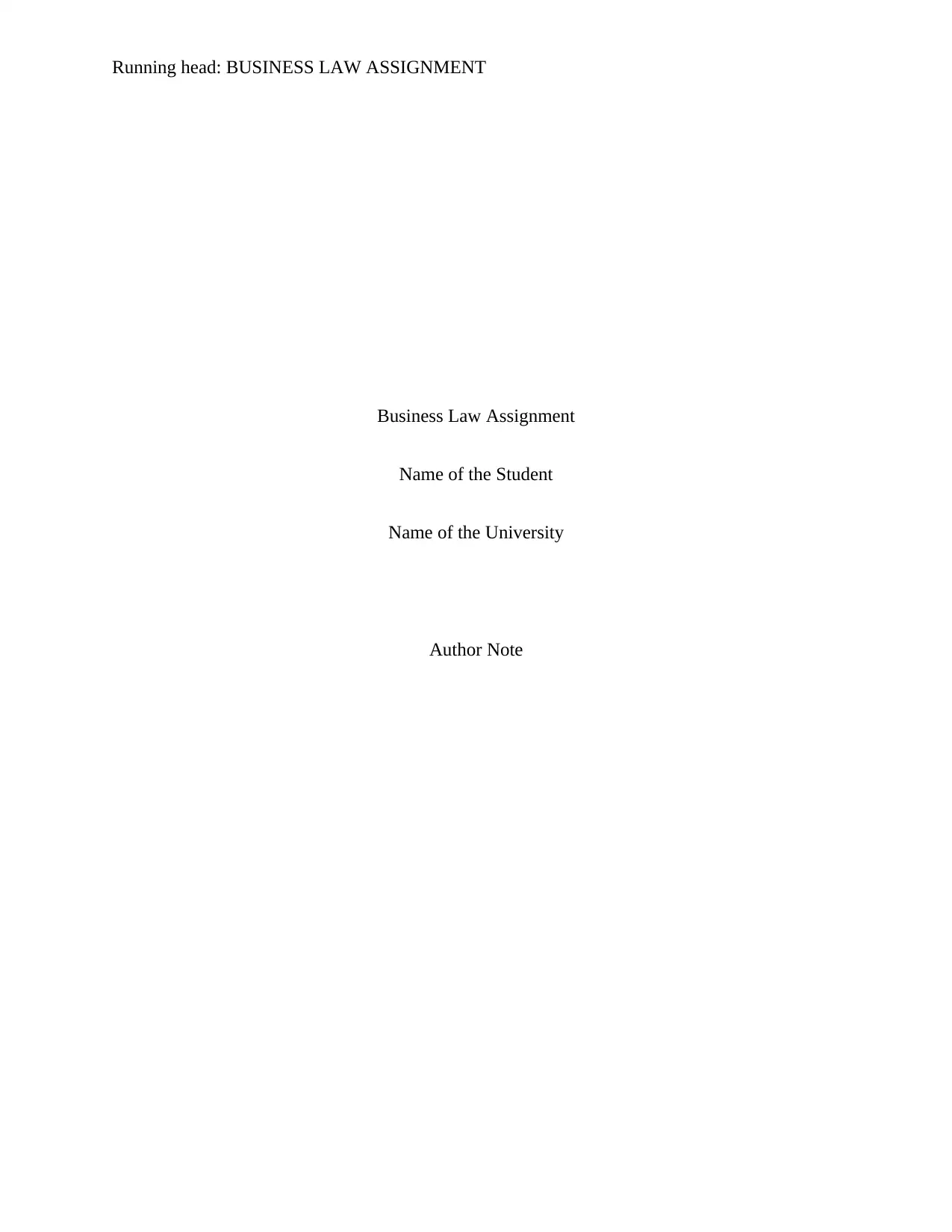
Running head: BUSINESS LAW ASSIGNMENT
Business Law Assignment
Name of the Student
Name of the University
Author Note
Business Law Assignment
Name of the Student
Name of the University
Author Note
Paraphrase This Document
Need a fresh take? Get an instant paraphrase of this document with our AI Paraphraser
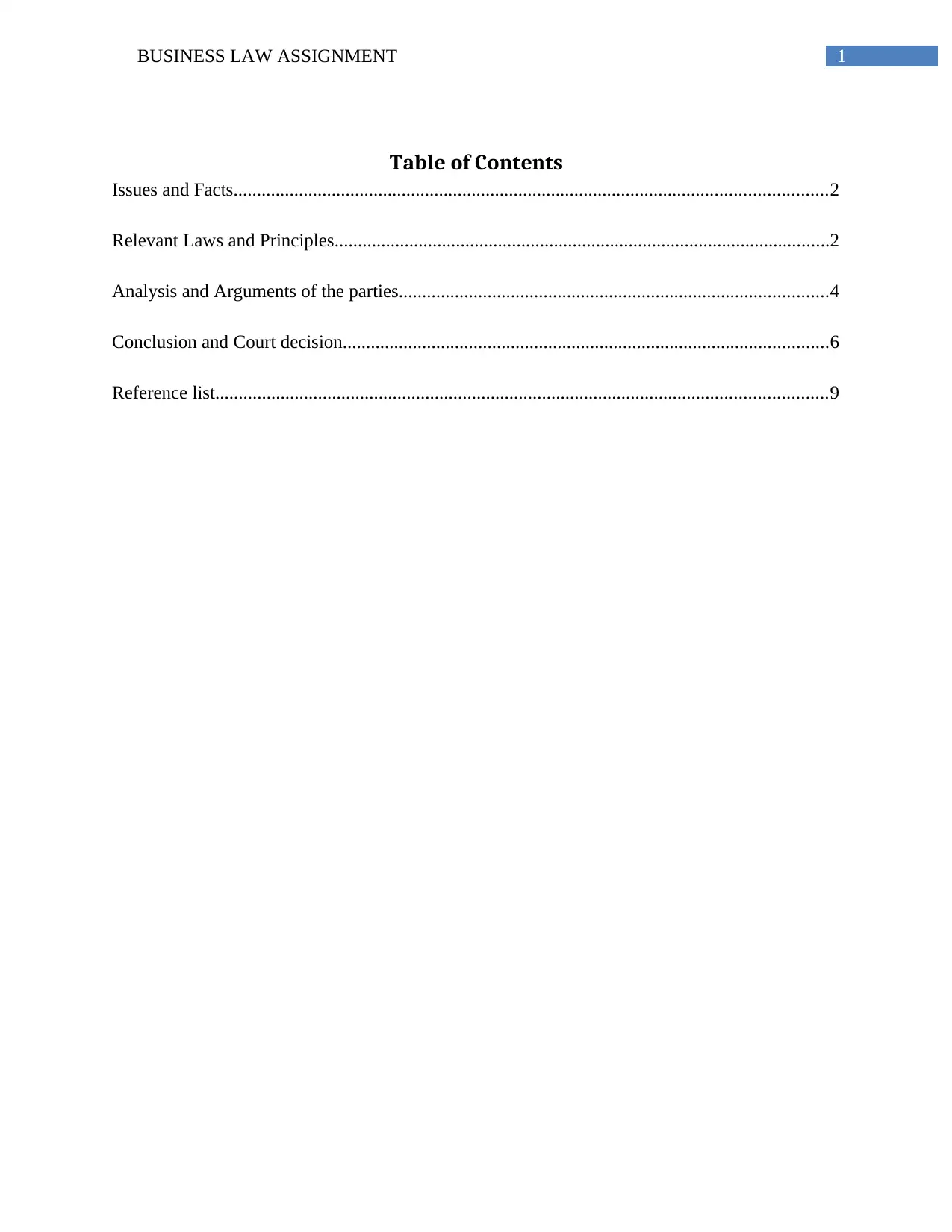
1BUSINESS LAW ASSIGNMENT
Table of Contents
Issues and Facts...............................................................................................................................2
Relevant Laws and Principles..........................................................................................................2
Analysis and Arguments of the parties............................................................................................4
Conclusion and Court decision........................................................................................................6
Reference list...................................................................................................................................9
Table of Contents
Issues and Facts...............................................................................................................................2
Relevant Laws and Principles..........................................................................................................2
Analysis and Arguments of the parties............................................................................................4
Conclusion and Court decision........................................................................................................6
Reference list...................................................................................................................................9
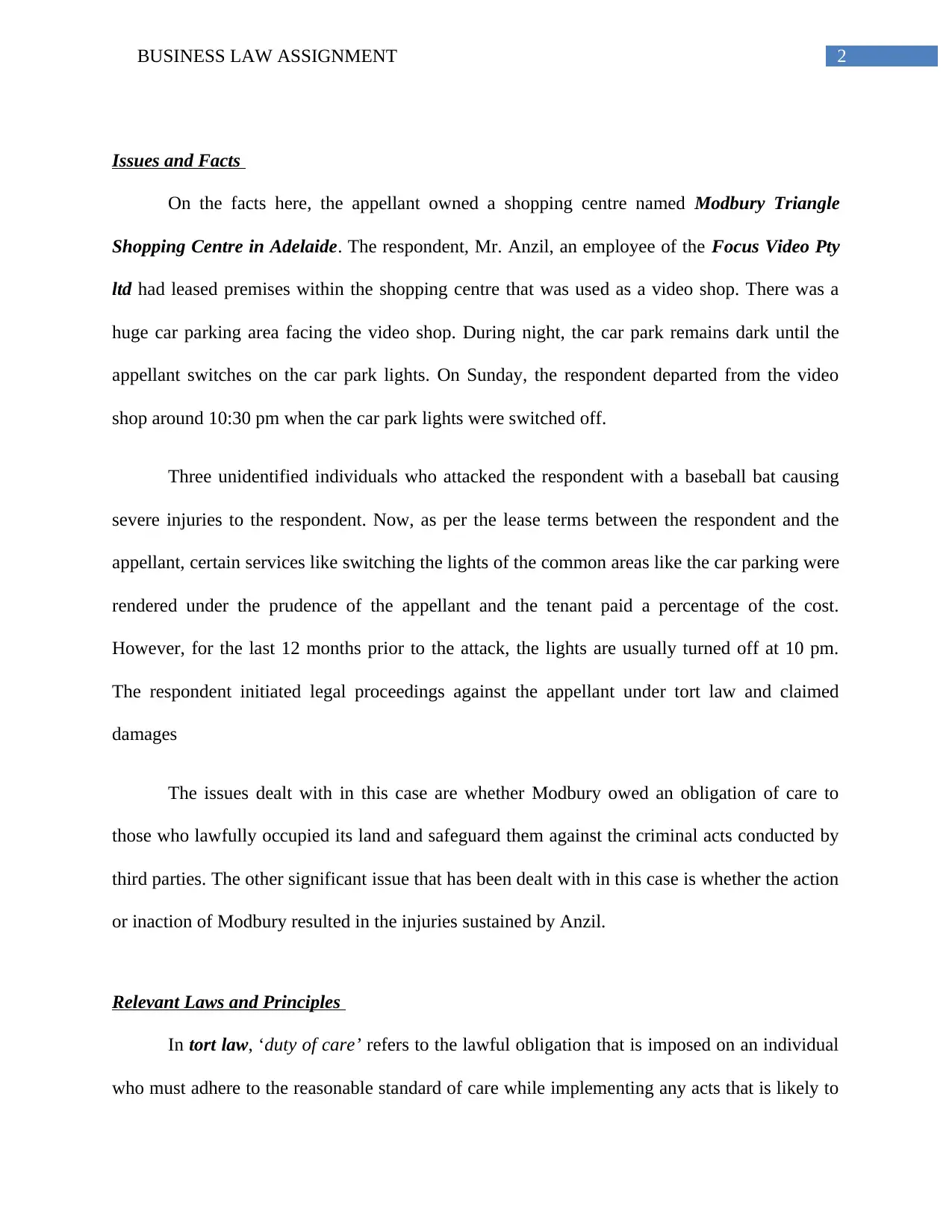
2BUSINESS LAW ASSIGNMENT
Issues and Facts
On the facts here, the appellant owned a shopping centre named Modbury Triangle
Shopping Centre in Adelaide. The respondent, Mr. Anzil, an employee of the Focus Video Pty
ltd had leased premises within the shopping centre that was used as a video shop. There was a
huge car parking area facing the video shop. During night, the car park remains dark until the
appellant switches on the car park lights. On Sunday, the respondent departed from the video
shop around 10:30 pm when the car park lights were switched off.
Three unidentified individuals who attacked the respondent with a baseball bat causing
severe injuries to the respondent. Now, as per the lease terms between the respondent and the
appellant, certain services like switching the lights of the common areas like the car parking were
rendered under the prudence of the appellant and the tenant paid a percentage of the cost.
However, for the last 12 months prior to the attack, the lights are usually turned off at 10 pm.
The respondent initiated legal proceedings against the appellant under tort law and claimed
damages
The issues dealt with in this case are whether Modbury owed an obligation of care to
those who lawfully occupied its land and safeguard them against the criminal acts conducted by
third parties. The other significant issue that has been dealt with in this case is whether the action
or inaction of Modbury resulted in the injuries sustained by Anzil.
Relevant Laws and Principles
In tort law, ‘duty of care’ refers to the lawful obligation that is imposed on an individual
who must adhere to the reasonable standard of care while implementing any acts that is likely to
Issues and Facts
On the facts here, the appellant owned a shopping centre named Modbury Triangle
Shopping Centre in Adelaide. The respondent, Mr. Anzil, an employee of the Focus Video Pty
ltd had leased premises within the shopping centre that was used as a video shop. There was a
huge car parking area facing the video shop. During night, the car park remains dark until the
appellant switches on the car park lights. On Sunday, the respondent departed from the video
shop around 10:30 pm when the car park lights were switched off.
Three unidentified individuals who attacked the respondent with a baseball bat causing
severe injuries to the respondent. Now, as per the lease terms between the respondent and the
appellant, certain services like switching the lights of the common areas like the car parking were
rendered under the prudence of the appellant and the tenant paid a percentage of the cost.
However, for the last 12 months prior to the attack, the lights are usually turned off at 10 pm.
The respondent initiated legal proceedings against the appellant under tort law and claimed
damages
The issues dealt with in this case are whether Modbury owed an obligation of care to
those who lawfully occupied its land and safeguard them against the criminal acts conducted by
third parties. The other significant issue that has been dealt with in this case is whether the action
or inaction of Modbury resulted in the injuries sustained by Anzil.
Relevant Laws and Principles
In tort law, ‘duty of care’ refers to the lawful obligation that is imposed on an individual
who must adhere to the reasonable standard of care while implementing any acts that is likely to
⊘ This is a preview!⊘
Do you want full access?
Subscribe today to unlock all pages.

Trusted by 1+ million students worldwide
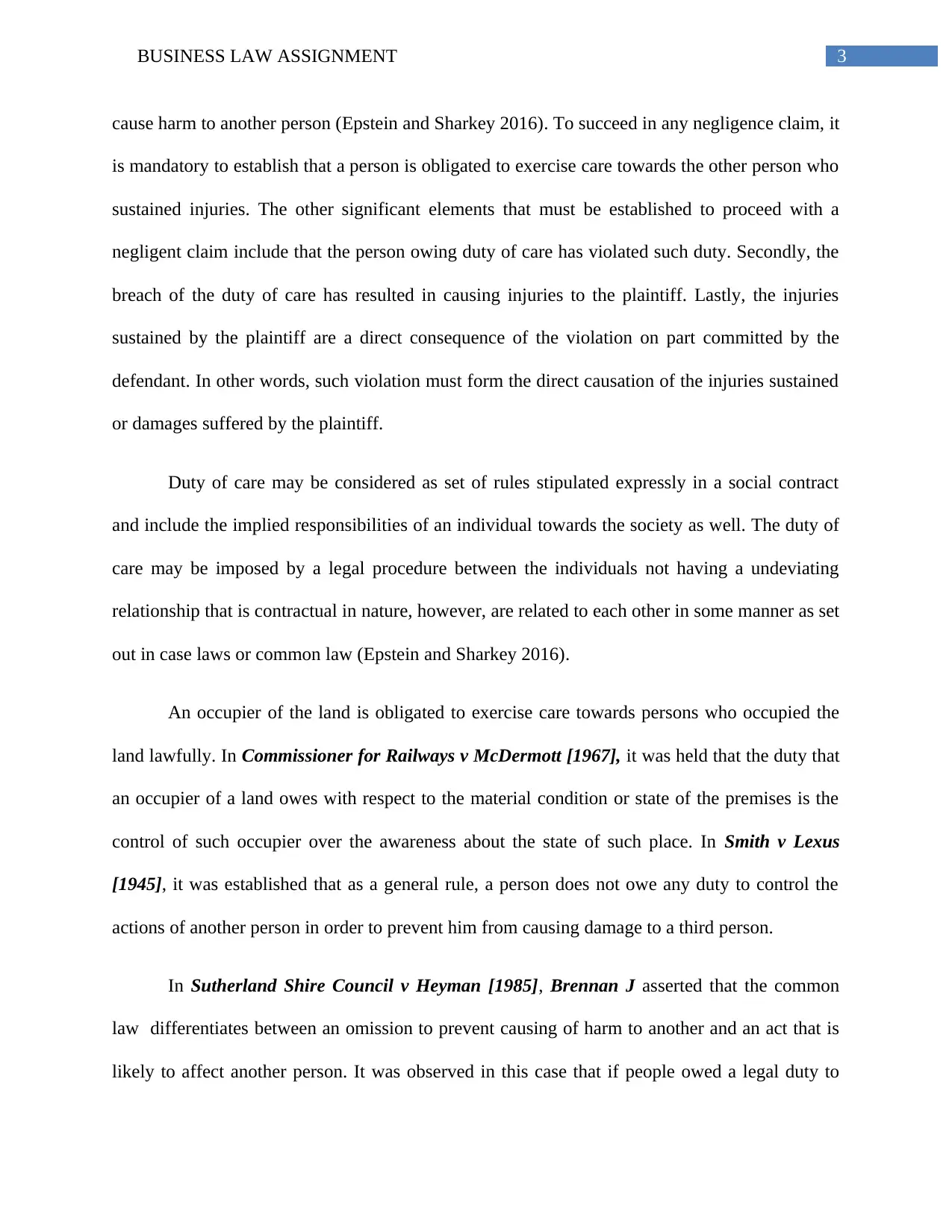
3BUSINESS LAW ASSIGNMENT
cause harm to another person (Epstein and Sharkey 2016). To succeed in any negligence claim, it
is mandatory to establish that a person is obligated to exercise care towards the other person who
sustained injuries. The other significant elements that must be established to proceed with a
negligent claim include that the person owing duty of care has violated such duty. Secondly, the
breach of the duty of care has resulted in causing injuries to the plaintiff. Lastly, the injuries
sustained by the plaintiff are a direct consequence of the violation on part committed by the
defendant. In other words, such violation must form the direct causation of the injuries sustained
or damages suffered by the plaintiff.
Duty of care may be considered as set of rules stipulated expressly in a social contract
and include the implied responsibilities of an individual towards the society as well. The duty of
care may be imposed by a legal procedure between the individuals not having a undeviating
relationship that is contractual in nature, however, are related to each other in some manner as set
out in case laws or common law (Epstein and Sharkey 2016).
An occupier of the land is obligated to exercise care towards persons who occupied the
land lawfully. In Commissioner for Railways v McDermott [1967], it was held that the duty that
an occupier of a land owes with respect to the material condition or state of the premises is the
control of such occupier over the awareness about the state of such place. In Smith v Lexus
[1945], it was established that as a general rule, a person does not owe any duty to control the
actions of another person in order to prevent him from causing damage to a third person.
In Sutherland Shire Council v Heyman [1985], Brennan J asserted that the common
law differentiates between an omission to prevent causing of harm to another and an act that is
likely to affect another person. It was observed in this case that if people owed a legal duty to
cause harm to another person (Epstein and Sharkey 2016). To succeed in any negligence claim, it
is mandatory to establish that a person is obligated to exercise care towards the other person who
sustained injuries. The other significant elements that must be established to proceed with a
negligent claim include that the person owing duty of care has violated such duty. Secondly, the
breach of the duty of care has resulted in causing injuries to the plaintiff. Lastly, the injuries
sustained by the plaintiff are a direct consequence of the violation on part committed by the
defendant. In other words, such violation must form the direct causation of the injuries sustained
or damages suffered by the plaintiff.
Duty of care may be considered as set of rules stipulated expressly in a social contract
and include the implied responsibilities of an individual towards the society as well. The duty of
care may be imposed by a legal procedure between the individuals not having a undeviating
relationship that is contractual in nature, however, are related to each other in some manner as set
out in case laws or common law (Epstein and Sharkey 2016).
An occupier of the land is obligated to exercise care towards persons who occupied the
land lawfully. In Commissioner for Railways v McDermott [1967], it was held that the duty that
an occupier of a land owes with respect to the material condition or state of the premises is the
control of such occupier over the awareness about the state of such place. In Smith v Lexus
[1945], it was established that as a general rule, a person does not owe any duty to control the
actions of another person in order to prevent him from causing damage to a third person.
In Sutherland Shire Council v Heyman [1985], Brennan J asserted that the common
law differentiates between an omission to prevent causing of harm to another and an act that is
likely to affect another person. It was observed in this case that if people owed a legal duty to
Paraphrase This Document
Need a fresh take? Get an instant paraphrase of this document with our AI Paraphraser
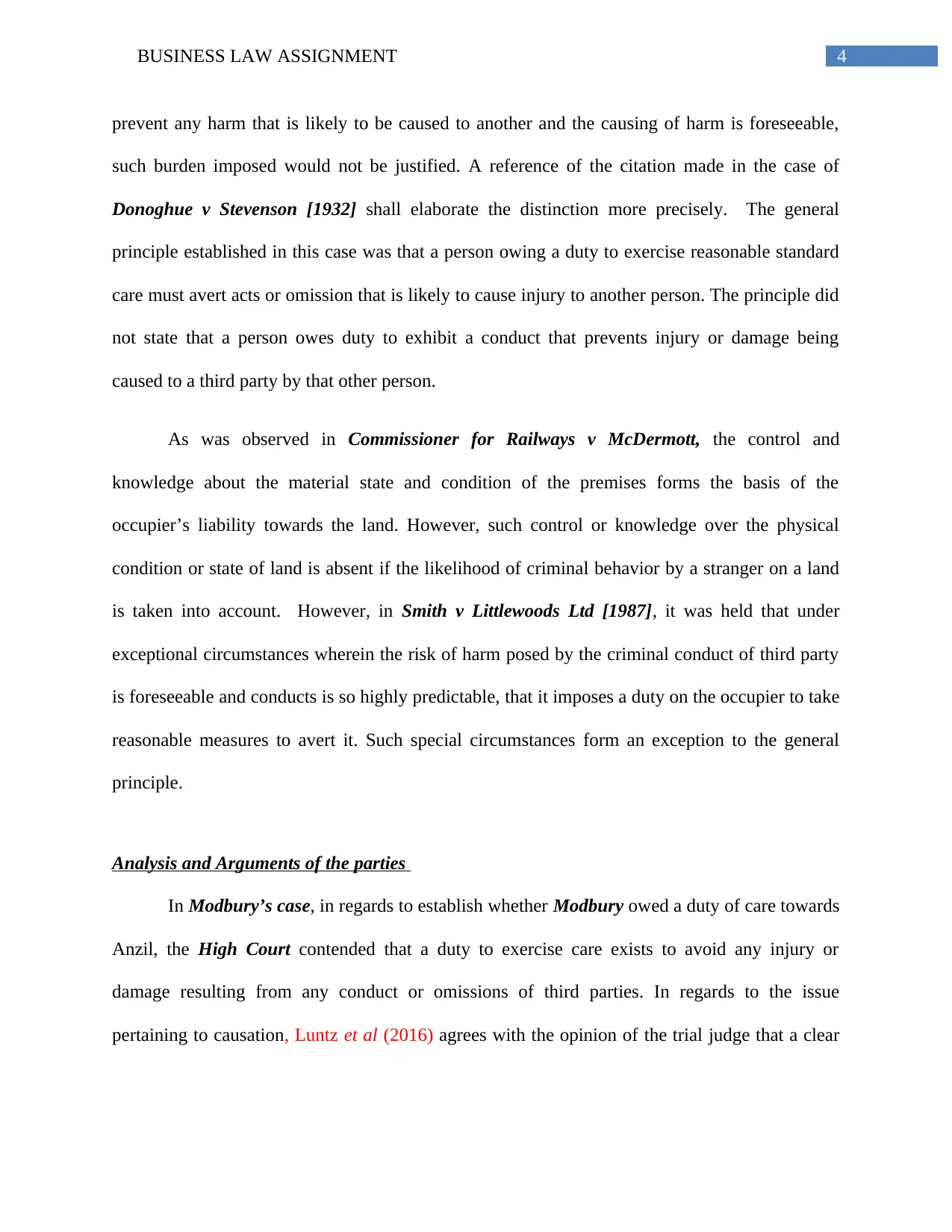
4BUSINESS LAW ASSIGNMENT
prevent any harm that is likely to be caused to another and the causing of harm is foreseeable,
such burden imposed would not be justified. A reference of the citation made in the case of
Donoghue v Stevenson [1932] shall elaborate the distinction more precisely. The general
principle established in this case was that a person owing a duty to exercise reasonable standard
care must avert acts or omission that is likely to cause injury to another person. The principle did
not state that a person owes duty to exhibit a conduct that prevents injury or damage being
caused to a third party by that other person.
As was observed in Commissioner for Railways v McDermott, the control and
knowledge about the material state and condition of the premises forms the basis of the
occupier’s liability towards the land. However, such control or knowledge over the physical
condition or state of land is absent if the likelihood of criminal behavior by a stranger on a land
is taken into account. However, in Smith v Littlewoods Ltd [1987], it was held that under
exceptional circumstances wherein the risk of harm posed by the criminal conduct of third party
is foreseeable and conducts is so highly predictable, that it imposes a duty on the occupier to take
reasonable measures to avert it. Such special circumstances form an exception to the general
principle.
Analysis and Arguments of the parties
In Modbury’s case, in regards to establish whether Modbury owed a duty of care towards
Anzil, the High Court contended that a duty to exercise care exists to avoid any injury or
damage resulting from any conduct or omissions of third parties. In regards to the issue
pertaining to causation, Luntz et al (2016) agrees with the opinion of the trial judge that a clear
prevent any harm that is likely to be caused to another and the causing of harm is foreseeable,
such burden imposed would not be justified. A reference of the citation made in the case of
Donoghue v Stevenson [1932] shall elaborate the distinction more precisely. The general
principle established in this case was that a person owing a duty to exercise reasonable standard
care must avert acts or omission that is likely to cause injury to another person. The principle did
not state that a person owes duty to exhibit a conduct that prevents injury or damage being
caused to a third party by that other person.
As was observed in Commissioner for Railways v McDermott, the control and
knowledge about the material state and condition of the premises forms the basis of the
occupier’s liability towards the land. However, such control or knowledge over the physical
condition or state of land is absent if the likelihood of criminal behavior by a stranger on a land
is taken into account. However, in Smith v Littlewoods Ltd [1987], it was held that under
exceptional circumstances wherein the risk of harm posed by the criminal conduct of third party
is foreseeable and conducts is so highly predictable, that it imposes a duty on the occupier to take
reasonable measures to avert it. Such special circumstances form an exception to the general
principle.
Analysis and Arguments of the parties
In Modbury’s case, in regards to establish whether Modbury owed a duty of care towards
Anzil, the High Court contended that a duty to exercise care exists to avoid any injury or
damage resulting from any conduct or omissions of third parties. In regards to the issue
pertaining to causation, Luntz et al (2016) agrees with the opinion of the trial judge that a clear
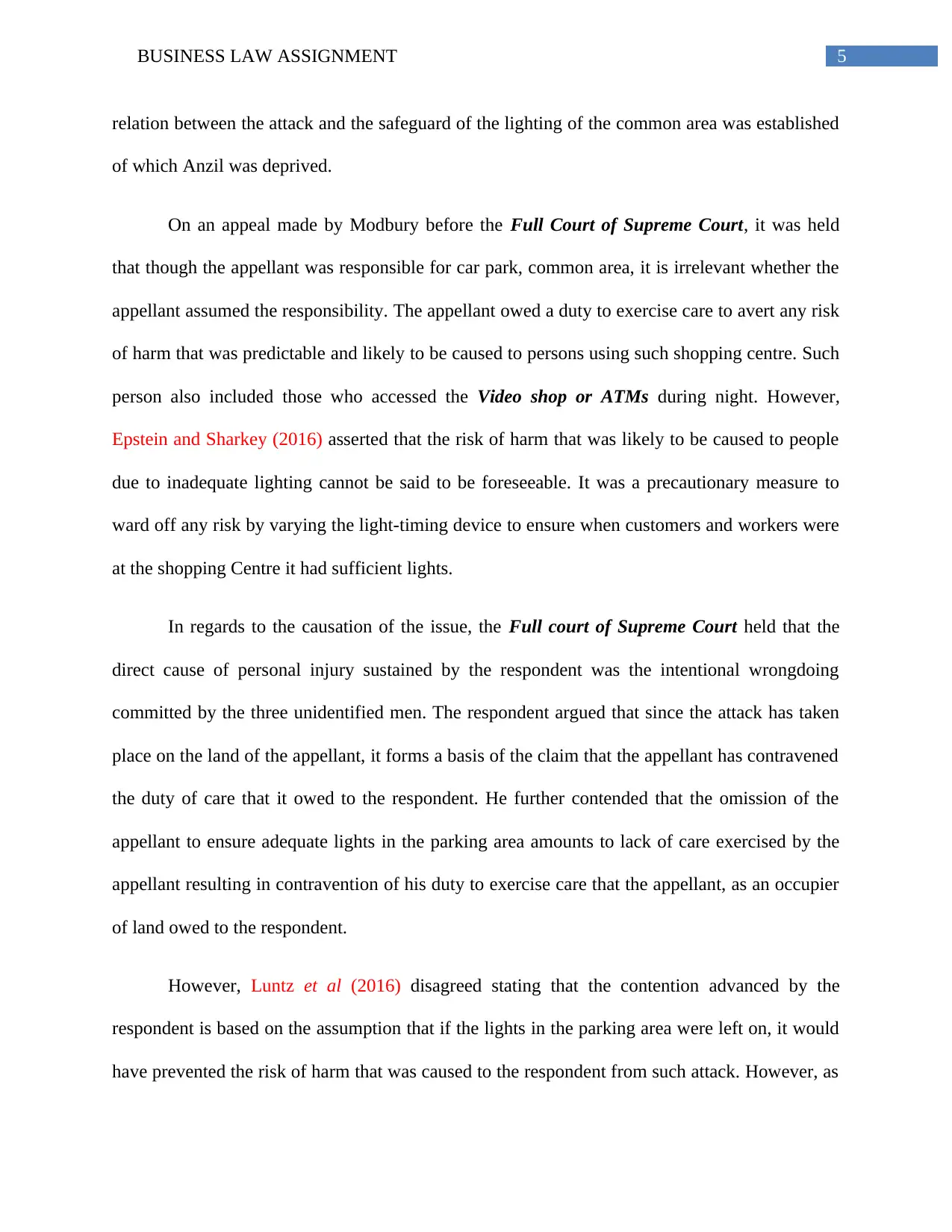
5BUSINESS LAW ASSIGNMENT
relation between the attack and the safeguard of the lighting of the common area was established
of which Anzil was deprived.
On an appeal made by Modbury before the Full Court of Supreme Court, it was held
that though the appellant was responsible for car park, common area, it is irrelevant whether the
appellant assumed the responsibility. The appellant owed a duty to exercise care to avert any risk
of harm that was predictable and likely to be caused to persons using such shopping centre. Such
person also included those who accessed the Video shop or ATMs during night. However,
Epstein and Sharkey (2016) asserted that the risk of harm that was likely to be caused to people
due to inadequate lighting cannot be said to be foreseeable. It was a precautionary measure to
ward off any risk by varying the light-timing device to ensure when customers and workers were
at the shopping Centre it had sufficient lights.
In regards to the causation of the issue, the Full court of Supreme Court held that the
direct cause of personal injury sustained by the respondent was the intentional wrongdoing
committed by the three unidentified men. The respondent argued that since the attack has taken
place on the land of the appellant, it forms a basis of the claim that the appellant has contravened
the duty of care that it owed to the respondent. He further contended that the omission of the
appellant to ensure adequate lights in the parking area amounts to lack of care exercised by the
appellant resulting in contravention of his duty to exercise care that the appellant, as an occupier
of land owed to the respondent.
However, Luntz et al (2016) disagreed stating that the contention advanced by the
respondent is based on the assumption that if the lights in the parking area were left on, it would
have prevented the risk of harm that was caused to the respondent from such attack. However, as
relation between the attack and the safeguard of the lighting of the common area was established
of which Anzil was deprived.
On an appeal made by Modbury before the Full Court of Supreme Court, it was held
that though the appellant was responsible for car park, common area, it is irrelevant whether the
appellant assumed the responsibility. The appellant owed a duty to exercise care to avert any risk
of harm that was predictable and likely to be caused to persons using such shopping centre. Such
person also included those who accessed the Video shop or ATMs during night. However,
Epstein and Sharkey (2016) asserted that the risk of harm that was likely to be caused to people
due to inadequate lighting cannot be said to be foreseeable. It was a precautionary measure to
ward off any risk by varying the light-timing device to ensure when customers and workers were
at the shopping Centre it had sufficient lights.
In regards to the causation of the issue, the Full court of Supreme Court held that the
direct cause of personal injury sustained by the respondent was the intentional wrongdoing
committed by the three unidentified men. The respondent argued that since the attack has taken
place on the land of the appellant, it forms a basis of the claim that the appellant has contravened
the duty of care that it owed to the respondent. He further contended that the omission of the
appellant to ensure adequate lights in the parking area amounts to lack of care exercised by the
appellant resulting in contravention of his duty to exercise care that the appellant, as an occupier
of land owed to the respondent.
However, Luntz et al (2016) disagreed stating that the contention advanced by the
respondent is based on the assumption that if the lights in the parking area were left on, it would
have prevented the risk of harm that was caused to the respondent from such attack. However, as
⊘ This is a preview!⊘
Do you want full access?
Subscribe today to unlock all pages.

Trusted by 1+ million students worldwide
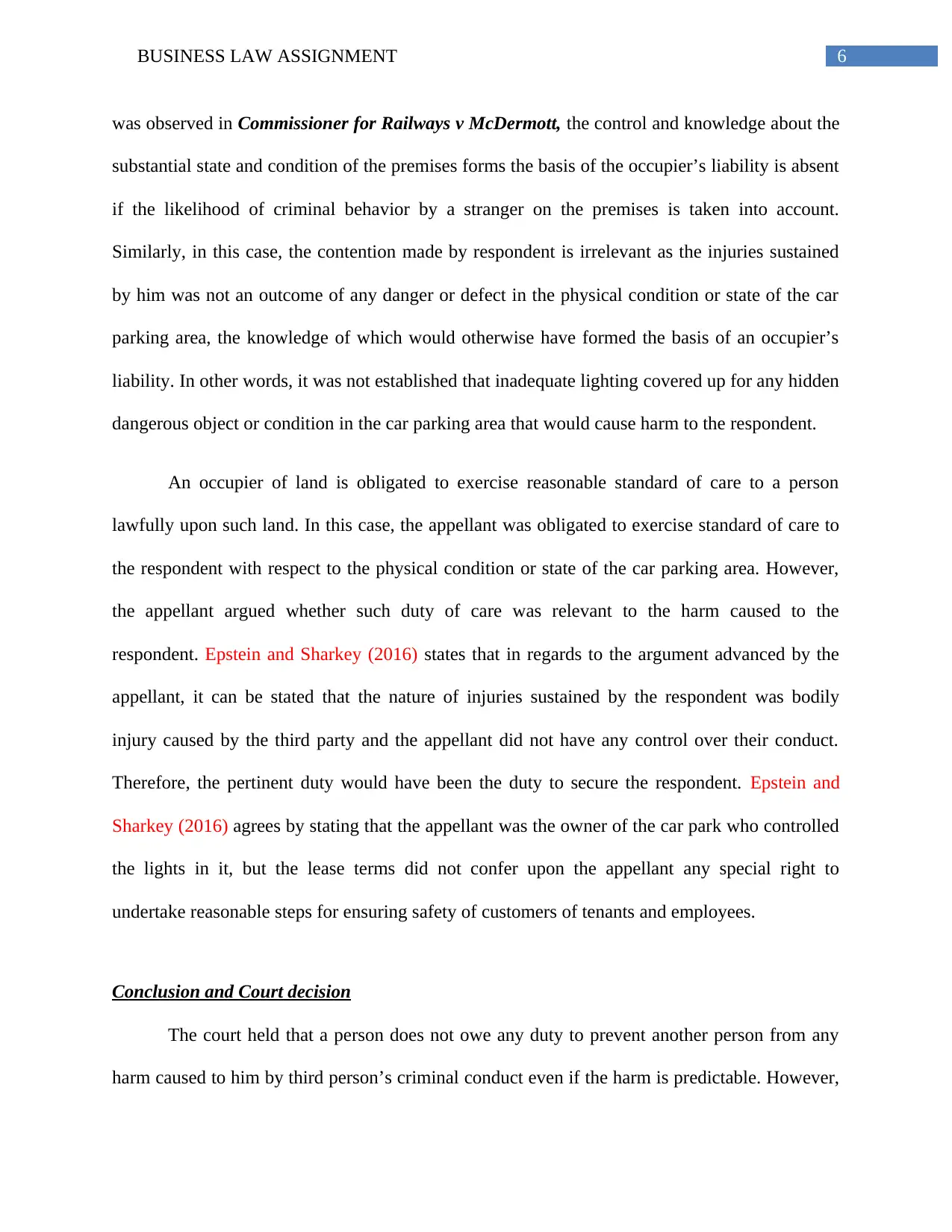
6BUSINESS LAW ASSIGNMENT
was observed in Commissioner for Railways v McDermott, the control and knowledge about the
substantial state and condition of the premises forms the basis of the occupier’s liability is absent
if the likelihood of criminal behavior by a stranger on the premises is taken into account.
Similarly, in this case, the contention made by respondent is irrelevant as the injuries sustained
by him was not an outcome of any danger or defect in the physical condition or state of the car
parking area, the knowledge of which would otherwise have formed the basis of an occupier’s
liability. In other words, it was not established that inadequate lighting covered up for any hidden
dangerous object or condition in the car parking area that would cause harm to the respondent.
An occupier of land is obligated to exercise reasonable standard of care to a person
lawfully upon such land. In this case, the appellant was obligated to exercise standard of care to
the respondent with respect to the physical condition or state of the car parking area. However,
the appellant argued whether such duty of care was relevant to the harm caused to the
respondent. Epstein and Sharkey (2016) states that in regards to the argument advanced by the
appellant, it can be stated that the nature of injuries sustained by the respondent was bodily
injury caused by the third party and the appellant did not have any control over their conduct.
Therefore, the pertinent duty would have been the duty to secure the respondent. Epstein and
Sharkey (2016) agrees by stating that the appellant was the owner of the car park who controlled
the lights in it, but the lease terms did not confer upon the appellant any special right to
undertake reasonable steps for ensuring safety of customers of tenants and employees.
Conclusion and Court decision
The court held that a person does not owe any duty to prevent another person from any
harm caused to him by third person’s criminal conduct even if the harm is predictable. However,
was observed in Commissioner for Railways v McDermott, the control and knowledge about the
substantial state and condition of the premises forms the basis of the occupier’s liability is absent
if the likelihood of criminal behavior by a stranger on the premises is taken into account.
Similarly, in this case, the contention made by respondent is irrelevant as the injuries sustained
by him was not an outcome of any danger or defect in the physical condition or state of the car
parking area, the knowledge of which would otherwise have formed the basis of an occupier’s
liability. In other words, it was not established that inadequate lighting covered up for any hidden
dangerous object or condition in the car parking area that would cause harm to the respondent.
An occupier of land is obligated to exercise reasonable standard of care to a person
lawfully upon such land. In this case, the appellant was obligated to exercise standard of care to
the respondent with respect to the physical condition or state of the car parking area. However,
the appellant argued whether such duty of care was relevant to the harm caused to the
respondent. Epstein and Sharkey (2016) states that in regards to the argument advanced by the
appellant, it can be stated that the nature of injuries sustained by the respondent was bodily
injury caused by the third party and the appellant did not have any control over their conduct.
Therefore, the pertinent duty would have been the duty to secure the respondent. Epstein and
Sharkey (2016) agrees by stating that the appellant was the owner of the car park who controlled
the lights in it, but the lease terms did not confer upon the appellant any special right to
undertake reasonable steps for ensuring safety of customers of tenants and employees.
Conclusion and Court decision
The court held that a person does not owe any duty to prevent another person from any
harm caused to him by third person’s criminal conduct even if the harm is predictable. However,
Paraphrase This Document
Need a fresh take? Get an instant paraphrase of this document with our AI Paraphraser
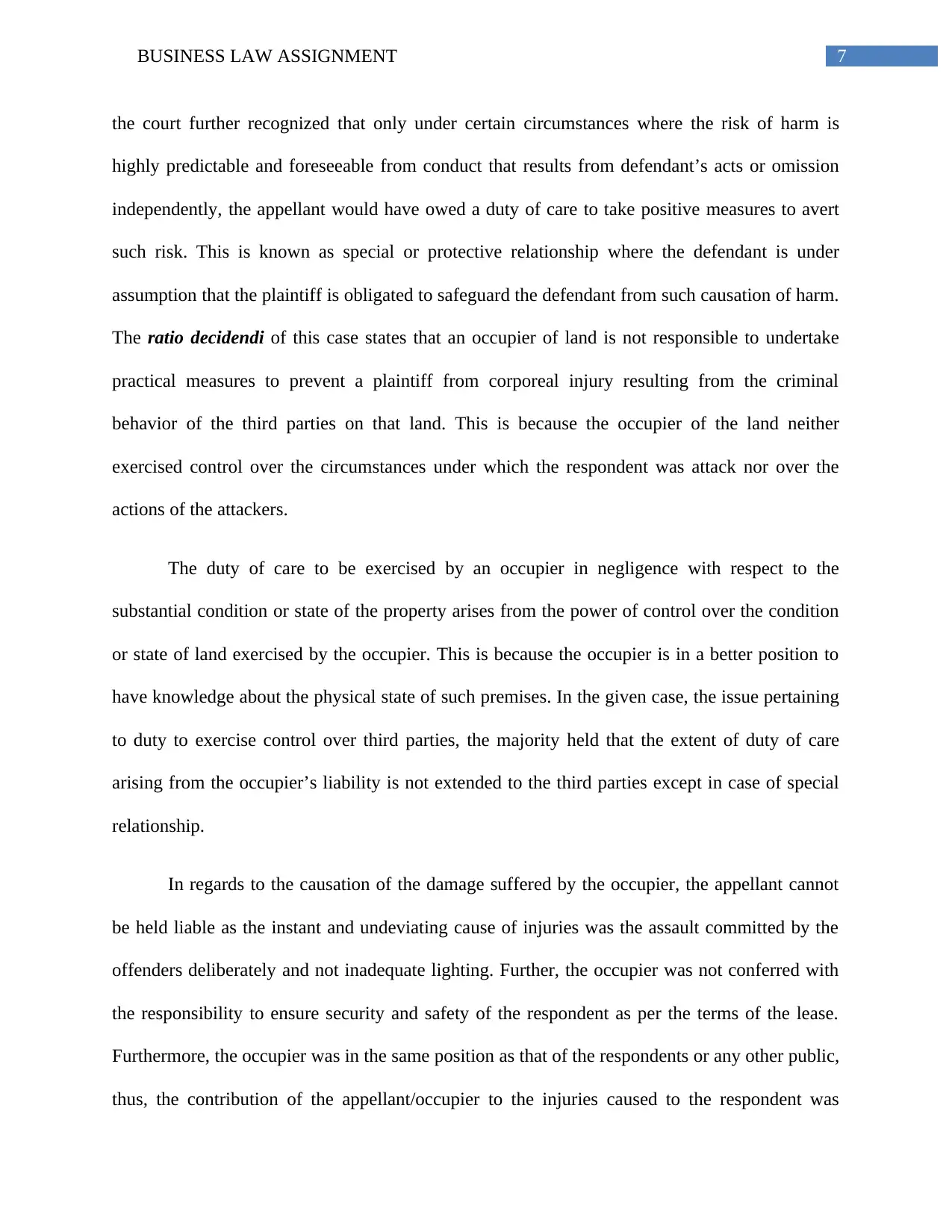
7BUSINESS LAW ASSIGNMENT
the court further recognized that only under certain circumstances where the risk of harm is
highly predictable and foreseeable from conduct that results from defendant’s acts or omission
independently, the appellant would have owed a duty of care to take positive measures to avert
such risk. This is known as special or protective relationship where the defendant is under
assumption that the plaintiff is obligated to safeguard the defendant from such causation of harm.
The ratio decidendi of this case states that an occupier of land is not responsible to undertake
practical measures to prevent a plaintiff from corporeal injury resulting from the criminal
behavior of the third parties on that land. This is because the occupier of the land neither
exercised control over the circumstances under which the respondent was attack nor over the
actions of the attackers.
The duty of care to be exercised by an occupier in negligence with respect to the
substantial condition or state of the property arises from the power of control over the condition
or state of land exercised by the occupier. This is because the occupier is in a better position to
have knowledge about the physical state of such premises. In the given case, the issue pertaining
to duty to exercise control over third parties, the majority held that the extent of duty of care
arising from the occupier’s liability is not extended to the third parties except in case of special
relationship.
In regards to the causation of the damage suffered by the occupier, the appellant cannot
be held liable as the instant and undeviating cause of injuries was the assault committed by the
offenders deliberately and not inadequate lighting. Further, the occupier was not conferred with
the responsibility to ensure security and safety of the respondent as per the terms of the lease.
Furthermore, the occupier was in the same position as that of the respondents or any other public,
thus, the contribution of the appellant/occupier to the injuries caused to the respondent was
the court further recognized that only under certain circumstances where the risk of harm is
highly predictable and foreseeable from conduct that results from defendant’s acts or omission
independently, the appellant would have owed a duty of care to take positive measures to avert
such risk. This is known as special or protective relationship where the defendant is under
assumption that the plaintiff is obligated to safeguard the defendant from such causation of harm.
The ratio decidendi of this case states that an occupier of land is not responsible to undertake
practical measures to prevent a plaintiff from corporeal injury resulting from the criminal
behavior of the third parties on that land. This is because the occupier of the land neither
exercised control over the circumstances under which the respondent was attack nor over the
actions of the attackers.
The duty of care to be exercised by an occupier in negligence with respect to the
substantial condition or state of the property arises from the power of control over the condition
or state of land exercised by the occupier. This is because the occupier is in a better position to
have knowledge about the physical state of such premises. In the given case, the issue pertaining
to duty to exercise control over third parties, the majority held that the extent of duty of care
arising from the occupier’s liability is not extended to the third parties except in case of special
relationship.
In regards to the causation of the damage suffered by the occupier, the appellant cannot
be held liable as the instant and undeviating cause of injuries was the assault committed by the
offenders deliberately and not inadequate lighting. Further, the occupier was not conferred with
the responsibility to ensure security and safety of the respondent as per the terms of the lease.
Furthermore, the occupier was in the same position as that of the respondents or any other public,
thus, the contribution of the appellant/occupier to the injuries caused to the respondent was
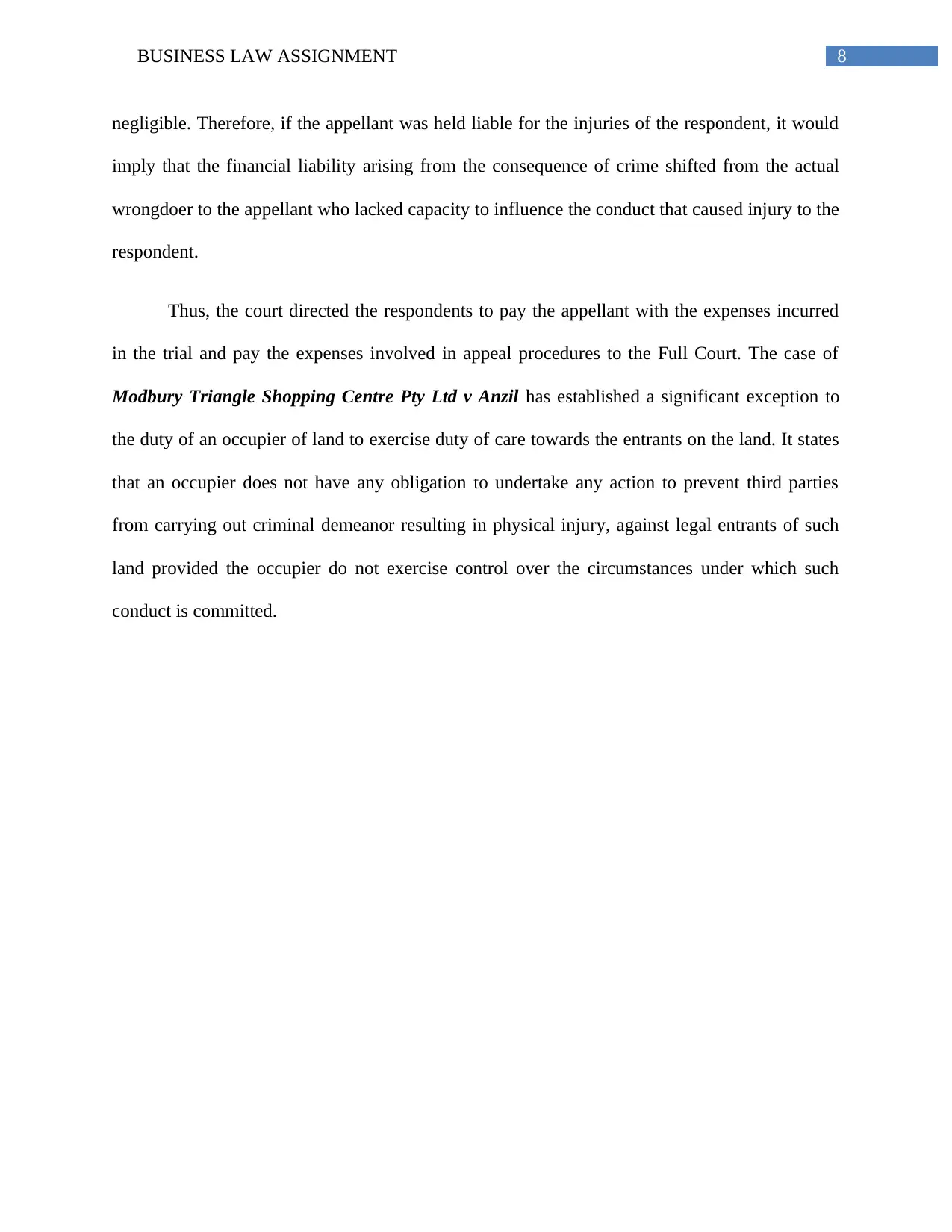
8BUSINESS LAW ASSIGNMENT
negligible. Therefore, if the appellant was held liable for the injuries of the respondent, it would
imply that the financial liability arising from the consequence of crime shifted from the actual
wrongdoer to the appellant who lacked capacity to influence the conduct that caused injury to the
respondent.
Thus, the court directed the respondents to pay the appellant with the expenses incurred
in the trial and pay the expenses involved in appeal procedures to the Full Court. The case of
Modbury Triangle Shopping Centre Pty Ltd v Anzil has established a significant exception to
the duty of an occupier of land to exercise duty of care towards the entrants on the land. It states
that an occupier does not have any obligation to undertake any action to prevent third parties
from carrying out criminal demeanor resulting in physical injury, against legal entrants of such
land provided the occupier do not exercise control over the circumstances under which such
conduct is committed.
negligible. Therefore, if the appellant was held liable for the injuries of the respondent, it would
imply that the financial liability arising from the consequence of crime shifted from the actual
wrongdoer to the appellant who lacked capacity to influence the conduct that caused injury to the
respondent.
Thus, the court directed the respondents to pay the appellant with the expenses incurred
in the trial and pay the expenses involved in appeal procedures to the Full Court. The case of
Modbury Triangle Shopping Centre Pty Ltd v Anzil has established a significant exception to
the duty of an occupier of land to exercise duty of care towards the entrants on the land. It states
that an occupier does not have any obligation to undertake any action to prevent third parties
from carrying out criminal demeanor resulting in physical injury, against legal entrants of such
land provided the occupier do not exercise control over the circumstances under which such
conduct is committed.
⊘ This is a preview!⊘
Do you want full access?
Subscribe today to unlock all pages.

Trusted by 1+ million students worldwide
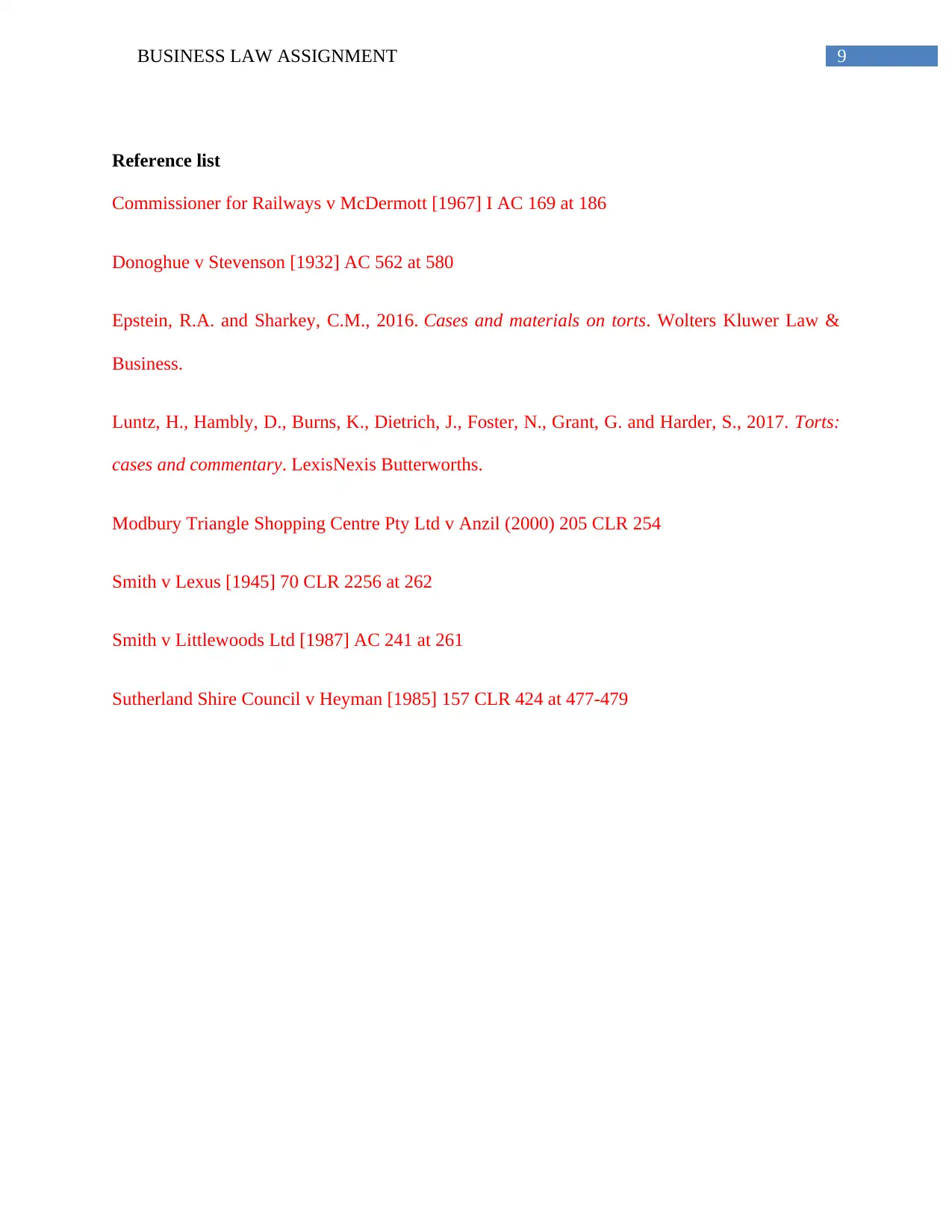
9BUSINESS LAW ASSIGNMENT
Reference list
Commissioner for Railways v McDermott [1967] I AC 169 at 186
Donoghue v Stevenson [1932] AC 562 at 580
Epstein, R.A. and Sharkey, C.M., 2016. Cases and materials on torts. Wolters Kluwer Law &
Business.
Luntz, H., Hambly, D., Burns, K., Dietrich, J., Foster, N., Grant, G. and Harder, S., 2017. Torts:
cases and commentary. LexisNexis Butterworths.
Modbury Triangle Shopping Centre Pty Ltd v Anzil (2000) 205 CLR 254
Smith v Lexus [1945] 70 CLR 2256 at 262
Smith v Littlewoods Ltd [1987] AC 241 at 261
Sutherland Shire Council v Heyman [1985] 157 CLR 424 at 477-479
Reference list
Commissioner for Railways v McDermott [1967] I AC 169 at 186
Donoghue v Stevenson [1932] AC 562 at 580
Epstein, R.A. and Sharkey, C.M., 2016. Cases and materials on torts. Wolters Kluwer Law &
Business.
Luntz, H., Hambly, D., Burns, K., Dietrich, J., Foster, N., Grant, G. and Harder, S., 2017. Torts:
cases and commentary. LexisNexis Butterworths.
Modbury Triangle Shopping Centre Pty Ltd v Anzil (2000) 205 CLR 254
Smith v Lexus [1945] 70 CLR 2256 at 262
Smith v Littlewoods Ltd [1987] AC 241 at 261
Sutherland Shire Council v Heyman [1985] 157 CLR 424 at 477-479
1 out of 10
Your All-in-One AI-Powered Toolkit for Academic Success.
+13062052269
info@desklib.com
Available 24*7 on WhatsApp / Email
![[object Object]](/_next/static/media/star-bottom.7253800d.svg)
Unlock your academic potential
Copyright © 2020–2025 A2Z Services. All Rights Reserved. Developed and managed by ZUCOL.

